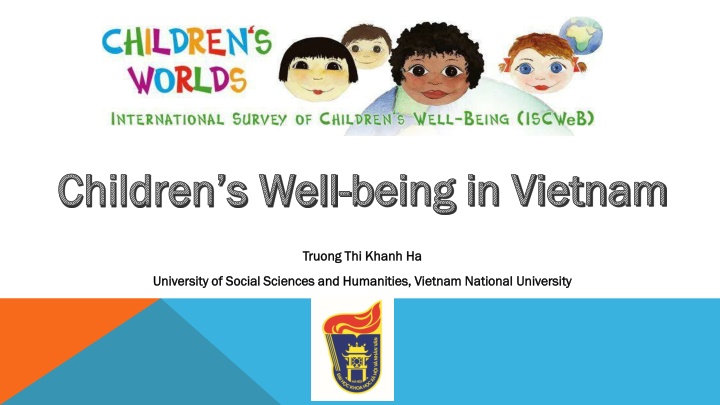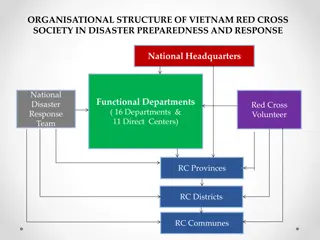
Children's Well-being in Vietnam: Insights and Challenges
Discover the state of children's well-being in Vietnam, including population demographics, family structure, and the education system. Explore the cultural aspects of child-rearing and education, as well as the challenges faced by schools in providing quality education.
Download Presentation

Please find below an Image/Link to download the presentation.
The content on the website is provided AS IS for your information and personal use only. It may not be sold, licensed, or shared on other websites without obtaining consent from the author. If you encounter any issues during the download, it is possible that the publisher has removed the file from their server.
You are allowed to download the files provided on this website for personal or commercial use, subject to the condition that they are used lawfully. All files are the property of their respective owners.
The content on the website is provided AS IS for your information and personal use only. It may not be sold, licensed, or shared on other websites without obtaining consent from the author.
E N D
Presentation Transcript
Childrens Well Children s Well- -being in Vietnam being in Vietnam Truong Truong Thi Thi Khanh Khanh Ha Ha University of Social Sciences and Humanities, Vietnam National University of Social Sciences and Humanities, Vietnam National University University
Vietnam is in South East Asia, facing China, Laos, Cambodia, and Pacific Ocean Vietnam is divided into three regions: North, Midle, and South. Population in 2017 was 96.160.163 (https://www.indexmundi.com/vietnam/d emographics_profile.html) Hue Danang Hanoi capital Haiphong HCM city Nhatrang
Population Population Age Age structure structure 96,160,163 (July 2017 est.) 0-14 years: 23.55% (male 11,909,326/female 10,735,324) Population growth Population growth 0.93% (2017 est.) rate rate Urbanization Urbanization urban population: 34.9% of total population (2017) Sex ratio Sex ratio Total fertility rate Total fertility rate Religions Religions at birth: 1.11 male(s)/female 1.81 children born/woman (2017 est.) Buddhist 7.9%, Catholic 6.6%, Hoa Hao 1.7%, Cao Dai 0.9%, Protestant 0.9%, Muslim 0.1%, none 81.8% (2009 est.)
The average number of children in the household is 1.81 There are more extended families in rural and mountain areas Family Family Vietnamese parents work hard Children are often reared by their grandparents, or spend long hours with house maids, or in private kindergarten In rural area every member of the family works hard. The elderly members of the family help with child care. Vietnamese children often join family work and participate in household chores, especially in rural and mountain areas.
Education System Education System Preschool is optional for children under six, however all children between 6 and 11 must go to primary school. Elementary education (primary school) lasts five years (grades 1 to 5, ages 6 - 11). Lower Secondary Education (middle school) lasts 4 years (grades 6 to 9, ages 11 15). Upper secondary education (high school): Most children move to high school at 15. It lasts three years (grades 10 to 12, ages 15-18).
Schools are not well equipped, and often overcrowded (Some students go to school in the morning; Other goes to school in the afternoons) Teachers frequently emphasis more on discipline in the schoolroom than on active interaction and discussions. Teachers try to give as much knowledge as possible to students, but not skills and ways of thinking
OUT OUT- -OF OF- -SCHOOL SCHOOL CHILDREN CHILDREN There is about 7% children don t have opportunity to go to primary and lower secondary schools. The out-of-primary school rate was 6,7%; out-of-lower-secondary school rate was 8.1% (Source: MOET, 2017). Out of school children often live in very poor conditions or lack of one or both parents.
Everyday life Everyday life In Vietnam, people in families often help each other. Towns and cities are very crowded and most people live in small apartments. Grandparents Grandparents help look help look after the after the small kids. small kids. Parents work Parents work hard. hard. Many Vietnamese people live in the country in small towns and villages. Kids older than 6 go Kids older than 6 go to school. to school.
Majority of the population living in rural areas and working in the paddy fields. Nowadays, many young people move to the big cities to work with the hope of larger income. Middle adults often choose to work in the suburbs, where they can live near their house and families.
Some problems and Child Polices Some problems and Child Polices A UNICEF report in 2015 showed that nearly 75% of children aged 2-14 in Vietnam have been violently abused by parents, caretakers, or other family members at least once (Source: GSO, 2015). Many left behind children in rural areas, who live with grandparents or relatives, while their parents work far away. Violent punishment (1 Violent punishment (1- -14 years): 68% 14 years): 68% Child Child labour labour (5 (5- -17 years): 16% 17 years): 16%
1.2 Sampling strategy and outcomes 1.2 Sampling strategy and outcomes Geographically, the North Vietnam can be divided into two regions: Red River Delta; Northern Midland and Mountain, so we choose the provinces from these two regions. (1) The Red River Delta The Red River Delta comprises 10 provinces and cities: Thai Binh, Nam Dinh, Ha Noi, Ninh Binh, Ha Nam, Bac Ninh, Hung Yen, Vinh Phuc, Hai Duong, Hai Phong. Population 20.439.400, in which number of children from 0 - 14 y/o contributes 22,7% (about 463.974.380 children) ( (Statistics, 2015) ) 8 year-old children in the 3rd grade 10 year-old children in the 5th grade 12 year-old children in the 7th grade (2) The Northern Midland and Mountain areas The Northern Midland and Mountain areas includes 15 provinces: Lao Cai, Lai Chau, Dien Bien, Son La, Hoa Binh, Yen Bai, Ha Giang, Cao Bang, Bac Kan, Thai Nguyen, Lang Son, Tuyen Quang, Bac Giang, Phu Tho, Quang Ninh. Population 11.508.100, in which number of children from 0 - 14 y/o contributes 26,5% (about 304.964.650 children) ( (Statistics, 2015) ) Each age group s total sample size was set at about 1.000.
The primary sampling unit was provinces and areas. First, we choose randomly 3 provinces in the Red River Delta (Vinh Phuc, Ha Noi, Ha Nam) and 4 provinces in the Northern Midland and Mountain (Son La, Bac Giang, Thai Nguyen, Quang Ninh). The urban, rural, and mountainous areas (depend on geographical characteristics of each province) are identified as the first sampling strata. There are 14 strata representing geographical regions of the North Vietnam, including: (1) Hanoi - urban, (2) Hanoi - rural, (3) Ha Nam - urban, (4) Ha Nam - rural, (5) Vinh Phuc - urban, (6) Vinh Phuc - rural (belong Region Red River Delta); (7) Thai Nguyen - Urban, (8) Thai Nguyen - rural, (9) Son La - urban, (10) Son La - mountain; (11) Bac Giang - urban, (12) Bac Giang - rural, (13) Quang Ninh - urban, (14) Quang Ninh mountain (belong Region Northern Midland and Mountain).
Second, a list of public schools of each stratum was completed. Third, schools were selected with uniform probability within each stratum from the list. Fourth, within each school one or two, or three class groups was randomly selected with uniform probability. The number of class groups depends on the estimated class group size, which is different in every school and every area. For example one class in mountainous areas may have only 9 pupils, while one class in urban areas of big cities may have more than 50 pupils. There was no requirement of parental consent for children to participate in the survey in Vietnam. However school rector board consent required for children to participate in the survey. The survey was administered by researchers, university students, and school teachers. The group survey, using pen and paper, was conducted in all school classes. The survey began in early 2018 and was completed by September 2018. The number of participants was bigger, however some schools don t give the consent for using the data in this project, so there is a lack of the data from some schools and areas.
Table 1 shows the resulting sample by stratum. There are a total of 2991 children in the study sample with 1.008 in the 8 year old group, 1.012 in the 10 year old group, and 1.091 in the 12 year old group. Table 1: The sample by stratum (Numbers Table 1: The sample by stratum (Numbers) ) All All 1 1 2 2 3 3 4 4 5 5 6 6 7 7 8 8 9 9 10 10 11 11 12 12 13 13 14 14 8 8 y.o y.o 948 145 63 120 89 104 - 100 - - 124 111 - - 92 10 10 y.o y.o 952 179 66 109 79 96 - 110 - - 116 107 - - 90 12 12 y.o y.o 1.091 168 66 126 113 123 60 125 - - 117 95 - - 98 Total Total 2.991 492 195 355 281 323 60 335 - - 357 313 - - 280
After data cleaning, the real number of participants as follow: Table 2: Achieved sample by stratum (Numbers Table 2: Achieved sample by stratum (Numbers) ) All All 1 1 2 2 3 3 4 4 5 5 6 6 7 7 8 8 9 9 10 10 11 11 12 12 13 13 14 14 8 8 y.o y.o 930 142 62 117 89 103 - 97 - - 120 109 - - 91 10 10 y.o y.o 946 177 66 107 79 96 - 108 - - 116 107 - - 90 12 12 y.o y.o 1.080 166 66 124 112 123 60 123 - - 115 94 - - 97 Total Total 2.956 485 194 348 280 322 60 328 - - 351 310 - - 278
The participants The participants Age and Age and gender gender The children s ages ranged from 8 to 12 year-olds. About 46.5% of the sample are girls. The study finds that about 2% of the children in the sample were not born in Vietnam Country of birth Country of birth Table 3: Age by gender (numbers Table 3: Age by gender (numbers) 8 year 8 year- -old old 10 year 10 year- -old old 12 year 12 year- -old old Total Total Boy Boy 478 496 578 1552 Girl Girl 435 444 497 1376 Missing Missing 17 6 5 28 Total Total 930 946 1080 2956
Your Your home and the people you live home and the people you live with with Children aged 10 and 12 were asked Which of the following best describes the home you live in? Most of the children (95.2%) lived with their family, while 1.4% lived in a foster home, 0.2% lived in children home. Only 2.2% of children answered they were living in another type of home (grandparents or relatives home, children in institutions, ). Table 4: The home type that children live in (10 & 12 year Table 4: The home type that children live in (10 & 12 year- -old) old) (%) (%) 10 year 10 year- -old old 12 year 12 year- -old old Total Total I live with my family I live with my family 903 1027 1930 I live in a foster home I live in a foster home 19 17 36 I live in a children s home I live in a children s home 3 2 5 I live in another type of home I live in another type of home 17 27 44 Missing Missing 5 7 12 946 1080 2026
Table 5. Number of brothers and sisters children have (including step Table 5. Number of brothers and sisters children have (including step brothers and step sisters brothers and step sisters) ) 0 0 1 1 2 2 3 3 4 4 5 5 6 6 7 7 8 8 9 9 10 10 11 11 12 12 13 13 10 10 y.o y.o 47 478 232 85 45 26 13 7 1 1 12 12 y.o y.o 51 538 246 133 49 22 10 5 7 2 2 1 1 M 10 = 1.77 (SD = 1.32) M 10 = 1.77 (SD = 1.32) M 12 = 1.83 (SD = 1.43 M 12 = 1.83 (SD = 1.43) )
Table 6. Parents live or work away from home for more than a month in the Table 6. Parents live or work away from home for more than a month in the last year (10 & 12 year last year (10 & 12 year- -old) old) No No Yes, in another part Yes, in another part Yes, in a different Yes, in a different Missing Missing of Vietnam of Vietnam country country Mother Mother 1743 (85.3%) 265 (13%) 3 (0.1%) 32 (1.6%) Father Father 1587 (77.7%) 402 (19.7%) 8 (0.4%) 46 (2.3%)
How satisfied are you with the people that you live with? How satisfied are you with the people that you live with? Children aged 8 were asked to rate their satisfaction with the people they live with using a five point emoticons scale, which was transformed into a scale ranging from zero to four. Table 7: Satisfaction with the people you live with (8 year Table 7: Satisfaction with the people you live with (8 year- -old) (n, %) N = 948 old) (n, %) N = 948 M (SD) M (SD) Very Very unhappy unhappy Unhappy Unhappy Middle Middle Happy Happy Very happy Very happy Missing Missing 0 0 1 1 2 2 3 3 4 4 3.40 (0.73) 3.40 (0.73) 6 (0.6%) 10 (1.1%) 71 (7.5%) 365 (38.5) 480 (50.6%) 16 (1.7%)
Children aged 10 and 12 were asked the same questions using an 11-point scale ranging from zero to 10. Table 8: Satisfaction with the people you live with (10, 12 year Table 8: Satisfaction with the people you live with (10, 12 year- -old) (n, %) N = old) (n, %) N = 2026 2026 Not at all satisfied Totally satisfied 0 0 1 1 2 2 3 3 4 4 5 5 6 6 7 7 8 8 9 9 10 10 Missing Missing M (SD) M (SD) 14 14 (0.7) (0.7) 14 (0.7) 24 (1.2) 18 (0.9) 185 (9.1) 121 (6.0) 65 (3.2) 127 (6.3) 232 (11.5) 354 (17.5) 846 (41.8) 26 (1.3) 8.12 (2.35)
Some differences in their satisfaction with people they live with were found by age, 10 year-old children were more satisfied than 12 year-old children Table 9. Differences in satisfaction with people children live with by age (N = 2000 Table 9. Differences in satisfaction with people children live with by age (N = 2000) ) M M SD SD p p 10 10 year year old old (n = 938) (n = 938) 8.36 2.30 0.000 12 12 year year old old (n = 1062) (n = 1062) 7.91 2.37
All age groups of children were asked about their views on their family and people in their family. Children were asked to rate their agreement with follow statements, using a 5-point scale (0: I do not agree, 1: I agree a little, 2: I agree somewhat, 3: I agree a lot, 4: I totally agree). Table 10. Children views on their family and people in their family Table 10. Children views on their family and people in their family 8 8 10 10 3.54 (0.91) 3.43 (0.93) 3.29 (1.05) 3.30 (1.10) 2.96 (1.24) 2.88 (1.34) 12 12 3.44 (0.96) 3.32 (1.04) 3.21 (1.10) 3.41 (1.04) 2.70 (1.34) 2.62 (1.44) p p There are people in my family who care about There are people in my family who care about me me If I have a problem, people in my family will If I have a problem, people in my family will help me help me We have a good time together in my family We have a good time together in my family 3.43 (1.00) 3.27 (1.04) 3.22 (1.14) 3.14 (1.21) 2.96 (1.27) 0.02 0.01 0.09 I feel safe at home I feel safe at home 0.03 My parents listen to me and take what I say My parents listen to me and take what I say into account into account My parents and I make decisions about my life My parents and I make decisions about my life together together 0.00 0.00
2.3. Overall subjective well 2.3. Overall subjective well- -being being The Children s Worlds survey included a variety of different measures asking about overall subjective well-being OLS OLS (Overall Life Satisfaction) One question about satisfaction with life as a whole CW CW- -SWBS SWBS (Children s Worlds Subjective Well-Being Scale) 6 items measuring cognitive subjective well-being (Based on the Student Life Satisfaction Scale by Huebner, 1991). CW CW- -DBSWBS DBSWBS (Children s Worlds Domain Based Subjective Well-Being Scale) 5 items measuring domain based cognitive subjective well-being (based on the Brief Multidimensional Student Life Satisfaction Scale by Seligson, Huebner & Valois, 2003). CW CW- -PNAS PNAS (Children s Worlds Positive and Negative Affect Scale) 6 items measuring affective subjective well-being: positive and negative affect (based on Barrett & Russell, 1998). CW CW- -PWBS PWBS (Children s Worlds Psychological Well-Being Scale) 6 items measuring psychological subjective well-being (based on Ryff, 1989)
Overall Overall life life satisfaction (OLS) satisfaction (OLS) Children who are 10 and 12 year-olds are asked to rate their overall life satisfaction ('life as a whole') using an 11-point scale, and children who are 8 year-olds are asked to use a 5-point emoticons scale. The distribution of each levels is shown in table On life as a whole, 45.6% of 10 and 12 year-olds were totally satisfied with their life, and 60.6% of 8 year-olds score maximum on the overall life satisfaction scale. Table Table 11. 11. Overall life satisfaction (10 & 12 year Overall life satisfaction (10 & 12 year- -old, n = 2043) (%) old, n = 2043) (%) 0 0 1 1 2 2 3 3 4 4 5 5 6 6 7 7 8 8 9 9 10 10 Vietnam Vietnam 2018 2018 1.4 0.6 0.7 1.1 1.4 5.3 3.5 6.8 12.6 21.1 45.6 Korea Korea 2016 2016 0.8 0.6 1.2 1.8 3.1 8.3 5.8 10. 1 14.2 15.2 39.1
Table Table 12. 12. Overall life satisfaction (8 year Overall life satisfaction (8 year- -old, n = 948) old, n = 948) (%) (%) 0 0 1 1 2 2 3 3 4 4 Vietnam 2018 Vietnam 2018 2.2 2.4 13.9 32.2 49.2 Korea 2016 Korea 2016 1.7 3.0 9.4 25.4 60.6
Table 13. CW-SWBS (Childrens Worlds Subjective Well-Being Scale) 8 year 8 year- -old (948) old (948) 10 year 10 year- -old (942) old (942) 12 year 12 year- -old (1078) old (1078) p p How you feel about life How you feel about life as whole as whole M SD M SD M SD 3.34 0.88 8.21 2.42 7.48 2.56 0.000 I enjoy my life I enjoy my life 3.19 0.93 8.29 2.36 8.08 2.33 0.040 My life is going well My life is going well 3.35 0.91 8.33 2.41 7.74 2.60 I have a good life I have a good life 0.000 3.12 1.02 7.62 2.67 6.77 2.84 The things that happen The things that happen in my life are excellent in my life are excellent 0.000 3.38 0.90 8.43 2.41 7.68 2.62 I like my life I like my life 0.000 3.40 0.91 8.51 3.54 7.72 2.67 I am happy with my life I am happy with my life 0.000 82.62 20.83 76.00 22.56 CW CW- -SWBS SWBS 82.54 16.95 0.000
Table 14. CW-DBSWBS (Childrens Worlds Domain Based Subjective Well-Being Scale) 8 year 8 year- -old (948) old (948) 10 year 10 year- -old (942) old (942) 12 year 12 year- -old (1078) old (1078) p p How satisfied are you How satisfied are you with: with: M SD M SD M SD 3.40 .731 8.37 2.30 7.90 2.39 0.000 The people you live with The people you live with 3.22 .855 7.44 2.52 7.34 2.52 0.342 Your friends Your friends 3.32 .786 8.40 2.10 7.94 2.29 0.000 Your life as a student Your life as a student 3.48 .809 8.48 2.11 7.67 2.49 0.000 The area where you live The area where you live 3.10 1.018 7.96 2.40 7.52 2.47 0.000 The way that you look The way that you look 82.62 13.74 81.22 16.47 76.91 16.74 CW CW- -DBSWBS DBSWBS 0.000
Table 15. Personal Well-being Index School Children (PWI-SC7) 8 year 8 year- -old (948) old (948) M 3.15 - 10 year 10 year- -old (942) old (942) M 8.21 7.82 12 year 12 year- -old (1078) old (1078) M 7.85 7.37 p p How satisfied are you How satisfied are you with: with: SD 0.96 SD 2.25 2.61 SD 2.38 2.65 0.000 0.000 How safe you feel How safe you feel The freedom you have The freedom you have 3.10 1.01 7.96 2.40 7.52 2.47 The way that you look The way that you look 0.000 - 7.32 2.85 7.13 2.69 What may happen later in What may happen later in your life your life How you are listened to How you are listened to by adults by adults in general in general 0.118 - 8.23 2.41 7.45 2.74 0.000 3.24 3.24 1.02 0.93 8.54 8.81 2.18 1.91 8.20 8.28 2.29 2.20 Your health Your health Your life as a whole Your life as a whole 0.001 0.000 81.58 16.35 77.13 17.07 79.55 16.91 PWI_7 PWI_7 0.000
Boy feel safe more than girl (n = 2010, 10-12 y/o) Boy Boy Girl Girl p p How satisfied are you with: How satisfied are you with: M SD M SD p 8.12 2.35 7.89 2.29 0.025 How safe you feel How safe you feel
Table 16. Variations in different measures of subjective well-being (8, 10 & 12 year-old) (Means) 8 year 8 year- -old (948) old (948) 10 year 10 year- -old (942) old (942) 12 year 12 year- -old (1078) old (1078) p p M SD M SD M SD 82.45 20.24 76.0097 22.56 82.54 16.95 SWBS SWBS 0.000 82.62 13.74 81.22 16.47 76.91 16.74 DBSWBS DBSWBS 0.000 81.58 16.35 77.13 17.07 79.55 16.91 PWI PWI 0.000 81.11 18.60 75.43 20.18 PAS PAS 0.000 42.36 27.59 46.12 27.53 NAS NAS 0.003
Table 17. 8 y/o children Never Never Sometim Sometim es es Often Often Always Always Don t know Don t know Last two weeks: How often feeling happy Last two weeks: How often feeling happy 3.8 14.9 17.3 45.0 19 Last two weeks: How often feeling sad Last two weeks: How often feeling sad 42.2 36.2 9.6 7.7 2.4
Variations in subjective well-being Table 18. Variations in different areas of subjective well-being (10 & 12 year-old) (Means) Urban 1019 Rural 543 Mountain 481 F p M SD M SD M SD 82.12 21.05 81.78 20.49 68.78 21.65 66.984 .000 SWBS 82.02 15.28 80.73 16.14 69.85 17.72 91.280 .000 DBSWB S PWI_7 81.17 17.17 80.16 17.33 73.57 14.30 32.479 .000 78.64 20.04 78.02 20.30 76.86 17.96 1.271 .281 PAS 47.16 28.54 44.19 26.15 38.38 26.27 15.877 .000 NAS
Table 19. Satisfaction with different aspects of life (10, 12 year-old) (Mean and SD) Satisfaction with: Satisfaction with: 10 year 10 year- -old old 12 year 12 year- -old old p p M SD 1.91 1.91 2.18 2.20 2.11 2.10 2.30 2.41 2.20 2.25 2.50 2.40 2.61 2.41 2.52 2.85 M SD 2.11 2.20 2.29 2.30 2.49 2.29 2.39 2.74 2.36 2.38 2.66 2.47 2.65 2.48 2.52 2.69 8.83 8.81 8.54 8.49 8.48 8.40 8.37 8.23 8.23 8.21 8.00 7.96 7.82 7.65 7.44 7.32 8.26 8.28 8.20 7.92 7.67 7.94 7.90 7.45 7.69 7.85 7.44 7.52 7.37 7.21 7.34 7.13 0.000 0.000 0.001 0.000 0.000 0.000 0.000 0.000 0.000 0.000 0.000 0.000 0.000 0.000 0.342 0.118 Things you have learned Things you have learned Your life as a whole Your life as a whole Your health Your health All the things you have All the things you have The area where you live The area where you live Your life as a student Your life as a student The people you live with The people you live with How you are listened to by adults in general How you are listened to by adults in general How you use your time How you use your time How safe you feel How safe you feel How much free time you have How much free time you have The way that you look The way that you look The freedom you have The freedom you have Other children in your class Other children in your class Your friends Your friends What may happen to you later in your life What may happen to you later in your life
CW-PWBS (Childrens Worlds Psychological Well-Being Scale) In 12-years-old survey Table 20. Psychological Well-Being of 12 year-old children (n = 1080) M M SD SD How much you agree with following: How much you agree with following: 7.84 2.64 I like being the way I am I like being the way I am 6.84 2.90 I am good at managing my daily responsibilities I am good at managing my daily responsibilities 7.77 2.42 People are generally pretty friendly towards me People are generally pretty friendly towards me 7.25 2.88 I have enough choice about how I spend my time I have enough choice about how I spend my time 7.97 2.45 I feel that I am learning a lot at the moment I feel that I am learning a lot at the moment 7.42 2.89 I feel positive about my future I feel positive about my future 75.07 19.42 PWBS (Psychological Well PWBS (Psychological Well- -Being Scale) Being Scale)
3. Conclusions The findings on children s subjective well-being show that: - Most children (about 80%) aged 8 to 12 in Vietnam are relatively satisfied and happy with their lives. On life as a whole, about 45.6% of the 10 and 12 year-olds and 49.2% of the 8 year-olds were totally satisfied with their life. - There are some differences in children s well-being responses by age group and area. When asked about various aspects of their home and family, the level of positive response was the lowest among the older age group (age 12). Children living in mountain and rural areas have lower subjective well-being than children living in urban area. - Children less satisfy with the freedom they have, other children in their class, their friends, and what may happen to them later in their life






















